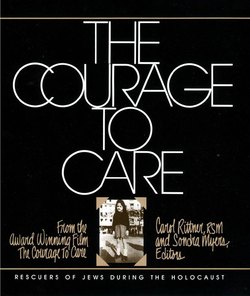Читать книгу The Courage to Care - Carol Rittner - Страница 7
На сайте Литреса книга снята с продажи.
PREFACE CAROL RITTNER, R.S.M.
ОглавлениеThe Holocaust and human decency. Perhaps no two terms could contradict each other more. Most studies of the Holocaust emphasize the abandonment of the Jews by non-Jews who lived under Nazi domination in Europe. It is difficult to do otherwise, for the evidence of human destruction speaks for itself. We cannot minimize or ignore it. During the 41 years since the Nazi death camps were liberated, documents have been collected and books written about the killers, about the victims, about the people who stood on the sidelines and watched without raising a voice in protest as the Jews of Europe were being brutalized and murdered.
We know, however, that during the Holocaust, there were a few people, many of whom were Christians, who could not stand by and do nothing while Jews—friends, neighbors, sometimes total strangers—were persecuted and hunted down. At great risk to themselves they took actions—sometimes large, more often small—which saved a life. Or many lives. And for these actions they are called in Hebrew, Hasidei Umot HaOlam, the “Righteous Among the Nations of the World.”
In 1953, the Israeli Knesset passed the Martyrs’ and Heroes’ Remembrance Law which outlined the functions of Yad Vashem, the Martyrs’ and Heroes’ Remembrance Authority in Jerusalem, and provided a definition, albeit inexact, of the “Righteous Among the Nations of the World.” Those people considered worthy of the title are defined as “the high-minded Gentiles who risked their lives to save Jews” during the Holocaust.
Certain criteria, established by Yad Vashem’s Commission for the Designation of the Righteous, must be fulfilled before a person can be named as one of the Hasidei Umot HaOlam. They are: extending help in saving the life of a Jewish man, woman or child during the Nazi persecution; endangering one’s own life; absence of reward, monetary or otherwise; and similar considerations, “which make the rescuer’s deeds stand out above and beyond what can be termed ordinary help, which is of course also praiseworthy.” To date, about 5,000 men and women have been identified and the accounts of their noble deeds verified. They are honored by Yad Vashem and the Jewish people worldwide as the “Righteous Among the Nations of the World.”
In September 1984, Elie Wiesel, noted author, teacher and Chairman of the United States Holocaust Memorial Council in Washington, D.C., convened an international conference, “Faith in Humankind: Rescuers of Jews During the Holocaust.” The purpose of the conference was to set forth side by side evidence of human degradation and evidence of human nobility, to illumine the deeds of the few who dared to defy evil at the risk of their own lives, and to bear witness to the world of what was done and could have been done if more people had had the courage to care.
The United States Holocaust Memorial Council wanted to focus on this small but significant chapter of the Holocaust in an effort to discover, if possible, in Elie Wiesel’s words, what made these few men and women “different from their fellow citizens? What compelled them to disregard danger and torture—even death—and choose humanity? What moved them to put their lives in jeopardy for the sake of saving one Jewish child, one Jewish mother?”
Surely not every question could be answered, but people did learn that there was and always is an alternative to passive complicity with evil. As Bayard Rustin, the civil rights leader and a member of the United States Holocaust Memorial Council, said at the opening ceremony, “It often took only a small act to save a life. It might have been opening a door, offering a hand, providing a hiding place, feeding a stranger, keeping a secret, or merely saying ’Yes!’ Each of these activities seems simple, small,” yet forty years ago, they provided a light in the vast darkness that was the Holocaust.
The “Righteous Among the Nations of the World” remind us of what so many people did not know—or forgot—during the Holocaust: that to be human means to care about people who are in danger. They remind us that every person is responsible for his or her actions, and that each one of us can make a difference.
The personal narratives and essays in this book have been collected in an effort to preserve the memory of noble deeds, to bear witness to the world that it was possible to help Jews in Nazi Germany and occupied Europe during World War II. A film, also entitled The Courage to Care, complements these first-person oral accounts and reflections by rescuers, survivors, and scholars. Although we cannot help but mourn the overwhelming dearth of “ordinary” human response to the Jews of Europe during the years 1933-45, we also must focus our attention on the few acts of caring and courage, if we are to provide examples of human decency for ourselves and our children.
